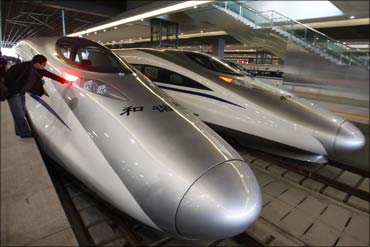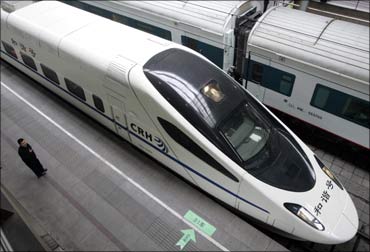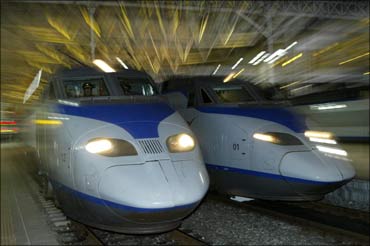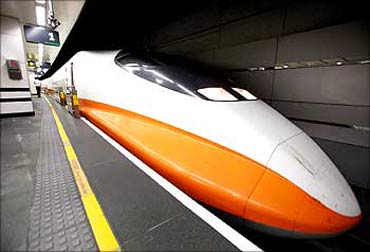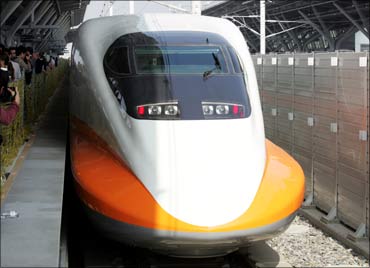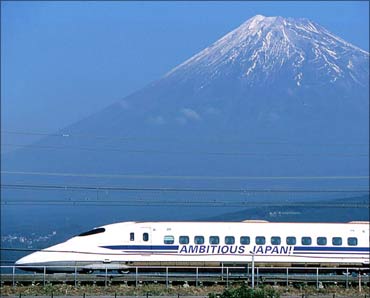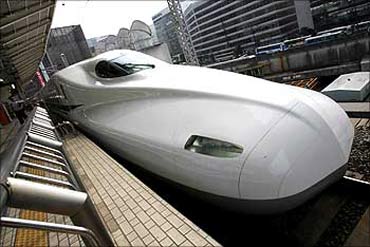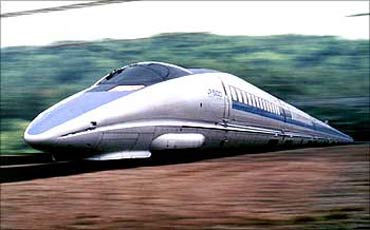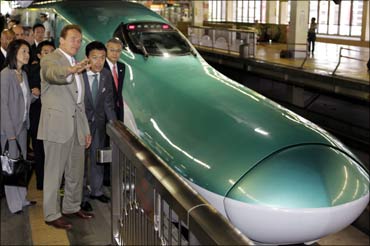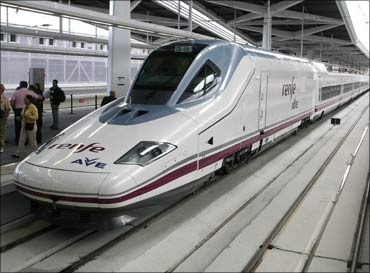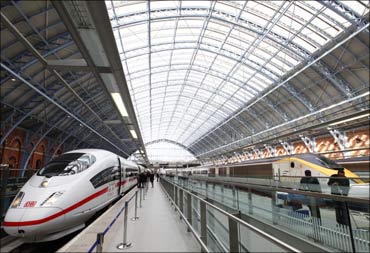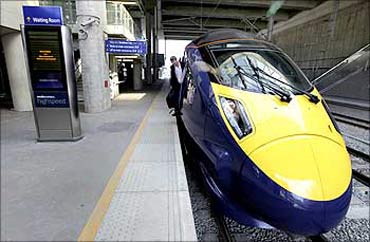 | « Back to article | Print this article |
The fastest trains in the world!
Can India have its first bullet train that would run at a speed of 350 km per hour? The proposal is being explored by Indian Railways with the help of three companies, including a French and an Italian firm.
The report of the feasibility study, being conducted on 533-km long Pune-Mumbai-Ahmedabad section, is expected to be submitted next month that will give an idea to the government whether or not to go ahead with such a proposal.
But when it comes to the world's fastest trains, China is the undisputed global champion currently.
The Shanghai Maglev Train is a magnetic levitation, or maglev, train that has a top speed of 431 kmph, making it the world's fastest commercial train. It is also called the He Xie.
The train, which China has the independent intellectual property rights of, will run for the first time on the Beijing-Shanghai high speed railway that is to be completed and opened in 2011.
Image: A man looks at the bullet trains serving the new high-speed railway linking Shanghai and Hangzhou in Shanghai.
Photograph: Aly Song/Reuters
Click NEXT to read on . . .
The fastest trains in the world!
The China Railway High-Speed (CRH) -- that rockets at an average speed train of 350 km per hour -- is the world's second fastest train. That is, if the train were to ply in India, it would take just 4 hours to run from Mumbai to Delhi.
The super-high-speed train connects the cities of Guangzhou, which is a business hub in southern China near Hong Kong, and Wuhan (a metropolis in central China). It is a distance of 1,069 km that takes only three hours to complete in the new high-speed train.
Experts say that these high-speed trains will not just shorten the distance between Chinese cities, but also drastically alter the pace at which China's economy is growing and will grow in the future, even as they bring the rural and urban populations much closer to each other.
Image: A labourer cleans the floor beside a China Railway High-speed (CRH) train preparing for the operation ceremony from Wuhan to Guangzhou in Wuhan, Hubei province.
Photograph: China Daily/Reuters
Click NEXT to read on . . .
The fastest trains in the world!
China has been developing the train for a while now, along with Siemens, Bombardier and Alstom. The CRH can zoom at speeds of 394 km per hour. With this, China's rail network of high-speed lines has risen to over 74,000 miles.
Image: A staff member stands at attention as a high-speed train leaves Beijing railway station.
High-speed trains with a speed of 200 km per hour or more are now a common sight on the Chinese railways.
Photograph: Jason Lee/Reuters
Click NEXT to read on . . .
The fastest trains in the world!
KTX, Korea
Korail, or South Korea's railway, operates the Korea Train eXpress (KTX) which has a high speed of 350 kmph.
Unlike the Chinese trains which are based on the Japanese bullet train models, the South Korea's high-speed rail system technology is based on the French Train de Grande Vitesse (TGV) system.
South Korea's first high-speed railway service began when a sleek, French-designed bullet train slipped out of Seoul bound for the southern port city of Pusan, now less than three hours away.
Image: A South Korean KTX train (L) prepares to depart for Pusan city at the Seoul railway station.
Photograph: Kim Kyung-Hoon/Reuters
Click NEXT to read on . . .
The fastest trains in the world!
Taiwan High Speed Rail
The Taiwan High Speed Rail can run at an average speed of 335 kmph.
The train plies between the cities of Kaohsiung and Taipei.
Image: A Taiwan High-Speed Railway train prepares to leave in Taipei.
Photograph: Nicky Loh/Reuters
Click NEXT to read on . . .
The fastest trains in the world!
Taiwan's first bullet train arrives at the platform in the southern county of Tainan.
Photograph: Reuters
Click NEXT to read on . . .
The fastest trains in the world!
Shinkanzen, Japan
The Japanese bullet trains are the first superfast railway systems to have wowed the world. A network of such of Shinkanzen trains connects Honshu with other major Japanese cities.
Image: Japan's bullet train, or the shinkansen, speeds past Mount Fuji in Fuji city, west of Tokyo.
Photograph: Reuters
Click NEXT to read on . . .
The fastest trains in the world!
Japan Railway's new N700 bullet train stands at a platform of Tokyo Station in Tokyo.
Photograph: Toru Hanai/Reuters
Click NEXT to read on . . .
The fastest trains in the world!
This montage picture shows Japan's bullet train, the 500-type Nozomi, developed by the West Japan Railway Co.
Reuters
Click NEXT to read on . . .
The fastest trains in the world!
California Governor Arnold Schwarzenegger (3rd R) and East Japan Railway's vice president Masaki Ogata (2nd R) stand beside a 'shinkansen', also known as a bullet train, during his tour of Japan's high-speed train operations at Omiya Station in Saitama, north of Tokyo.
Photograph: Shuji Kajiyama/Pool/Reuters
Click NEXT to read on . . .
The fastest trains in the world!
TGV, France
A high speed train service of France, the TGV rail service was developed by the French national rail operator, SNCF and GEC-Alsthom (now Alstom). The TGV rail network connects Paris with other important cities of France and also nearby countries.
The AGV is unveiled in the city of La Rochellein France.
French engineering giant Alstom unveiled the new generation of faster high-speed trains on Tuesday in a bid to keep ahead of rivals Siemens and Bombardier in the multi-billion dollar rail transport market.
Image: The prototype AGV (Automotrice Grande Vitesse) -- a successor to France's hallmark TGV fast train network -- will have a commercial speed of 360 kmph (223.7 miles) versus 320 for current models, the manufacturer said.
Photograph: Regis Duvignau/Reuters
Click NEXT to read on . . .
The fastest trains in the world!
A view of the cabin of the French AGV is seen in La Rochelle.
Photograph: Regis Duvignau/Reuters
Click NEXT to read on . . .
The fastest trains in the world!
Stationary high speed trains TGV are seen in the Lyon Perrache railway station in Lyon, southeastern France.
Photograph: Robert Pratta/Reuters
Click NEXT to read on . . .
The fastest trains in the world!
AVE, Spain
AVE, or the Alta Velocidad Espanola, are the fastest trains running in Spain and they can operate at super speeds of 300 kmph.
Almost all the major cities in Spain are connected by this superfast train network.
A high-speed AVE train, which has a top speed of between 300-350 kmh (186-217 mph), is seen at the Joaquin Sorolla station after a 98-km (61-mile) test ride with passengers from Hoya de Roda to Valencia.
Image: A one-and-a-half hour one-way ride on the first train linking Madrid and Valencia will be operational from December 18.
Photograph: Heino Kalis/Reuters
Click NEXT to read on . . .
The fastest trains in the world!
Eurostar, UK, Germany
The new ICE German high speed train is seen after it arrived at St Pancras station in London.
Deutsche Bahn showcased a Siemens high-speed train in London on Tuesday which it hopes will run services to Germany through the Channel Tunnel, challenging Eurostar's monopoly and Alstom trains.
Deutsche Bahn is aiming to operate services from London to Frankfurt and Cologne by the end of 2013.
Image: The ICE 3 train, which can hit 320 kilometres per hour, was on display at London's St Pancras station following safety tests.
Photograph: Andrew Winning/Reuters
Click NEXT to read on . . .
The fastest trains in the world!
A high speed train service in Western Europe, Eurostar connects London and Kent in the United Kingdom, with Brussels in Belgium and Paris and Lille in France. There are also seasonal trains to France and limited services to Disneyland Resort Paris.
Image: The first German high speed train (L) to travel through the Channel Tunnel sits next to a Eurostar train at St Pancras station in London.
Photograph: Andrew Winning/Reuters
Click NEXT to read on . . .
The fastest trains in the world!
A high speed 'Javelin' train waits at a platform at Stratford International Station in Stratford, east London.
Photograph: Stephen Hird/Reuters
